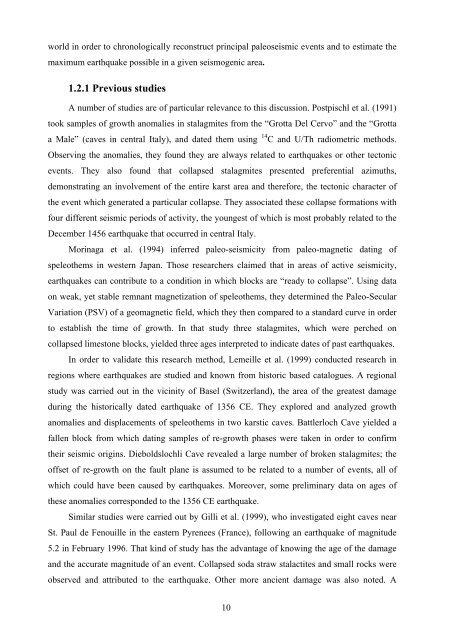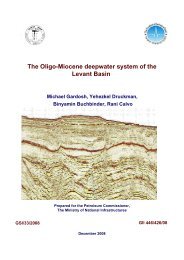tivity on the carmel faul
tivity on the carmel faul
tivity on the carmel faul
Create successful ePaper yourself
Turn your PDF publications into a flip-book with our unique Google optimized e-Paper software.
world in order to chr<strong>on</strong>ologically rec<strong>on</strong>struct principal paleoseismic events and to estimate <strong>the</strong><br />
maximum earthquake possible in a given seismogenic area.<br />
1.2.1 Previous studies<br />
A number of studies are of particular relevance to this discussi<strong>on</strong>. Postpischl et al. (1991)<br />
took samples of growth anomalies in stalagmites from <strong>the</strong> “Grotta Del Cervo” and <strong>the</strong> “Grotta<br />
a Male” (caves in central Italy), and dated <strong>the</strong>m using 14 C and U/Th radiometric methods.<br />
Observing <strong>the</strong> anomalies, <strong>the</strong>y found <strong>the</strong>y are always related to earthquakes or o<strong>the</strong>r tect<strong>on</strong>ic<br />
events. They also found that collapsed stalagmites presented preferential azimuths,<br />
dem<strong>on</strong>strating an involvement of <strong>the</strong> entire karst area and <strong>the</strong>refore, <strong>the</strong> tect<strong>on</strong>ic character of<br />
<strong>the</strong> event which generated a particular collapse. They associated <strong>the</strong>se collapse formati<strong>on</strong>s with<br />
four different seismic periods of ac<str<strong>on</strong>g>tivity</str<strong>on</strong>g>, <strong>the</strong> youngest of which is most probably related to <strong>the</strong><br />
December 1456 earthquake that occurred in central Italy.<br />
Morinaga et al. (1994) inferred paleo-seismicity from paleo-magnetic dating of<br />
speleo<strong>the</strong>ms in western Japan. Those researchers claimed that in areas of active seismicity,<br />
earthquakes can c<strong>on</strong>tribute to a c<strong>on</strong>diti<strong>on</strong> in which blocks are “ready to collapse”. Using data<br />
<strong>on</strong> weak, yet stable remnant magnetizati<strong>on</strong> of speleo<strong>the</strong>ms, <strong>the</strong>y determined <strong>the</strong> Paleo-Secular<br />
Variati<strong>on</strong> (PSV) of a geomagnetic field, which <strong>the</strong>y <strong>the</strong>n compared to a standard curve in order<br />
to establish <strong>the</strong> time of growth. In that study three stalagmites, which were perched <strong>on</strong><br />
collapsed limest<strong>on</strong>e blocks, yielded three ages interpreted to indicate dates of past earthquakes.<br />
In order to validate this research method, Lemeille et al. (1999) c<strong>on</strong>ducted research in<br />
regi<strong>on</strong>s where earthquakes are studied and known from historic based catalogues. A regi<strong>on</strong>al<br />
study was carried out in <strong>the</strong> vicinity of Basel (Switzerland), <strong>the</strong> area of <strong>the</strong> greatest damage<br />
during <strong>the</strong> historically dated earthquake of 1356 CE. They explored and analyzed growth<br />
anomalies and displacements of speleo<strong>the</strong>ms in two karstic caves. Battlerloch Cave yielded a<br />
fallen block from which dating samples of re-growth phases were taken in order to c<strong>on</strong>firm<br />
<strong>the</strong>ir seismic origins. Dieboldslochli Cave revealed a large number of broken stalagmites; <strong>the</strong><br />
offset of re-growth <strong>on</strong> <strong>the</strong> <strong>faul</strong>t plane is assumed to be related to a number of events, all of<br />
which could have been caused by earthquakes. Moreover, some preliminary data <strong>on</strong> ages of<br />
<strong>the</strong>se anomalies corresp<strong>on</strong>ded to <strong>the</strong> 1356 CE earthquake.<br />
Similar studies were carried out by Gilli et al. (1999), who investigated eight caves near<br />
St. Paul de Fenouille in <strong>the</strong> eastern Pyrenees (France), following an earthquake of magnitude<br />
5.2 in February 1996. That kind of study has <strong>the</strong> advantage of knowing <strong>the</strong> age of <strong>the</strong> damage<br />
and <strong>the</strong> accurate magnitude of an event. Collapsed soda straw stalactites and small rocks were<br />
observed and attributed to <strong>the</strong> earthquake. O<strong>the</strong>r more ancient damage was also noted. A<br />
10

















